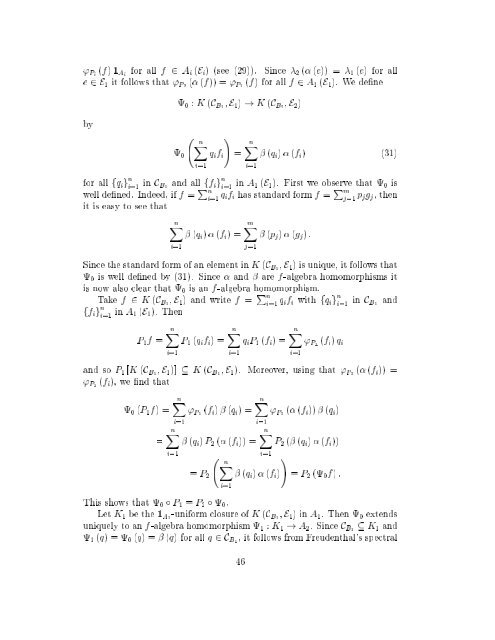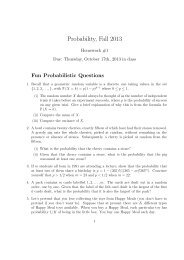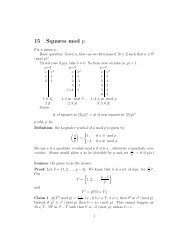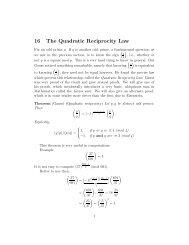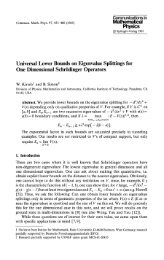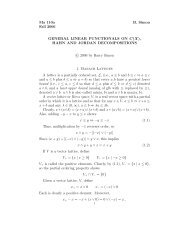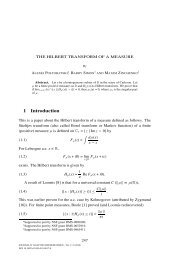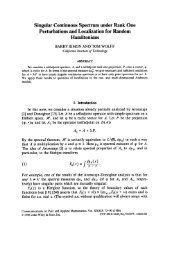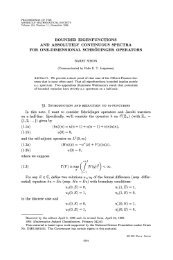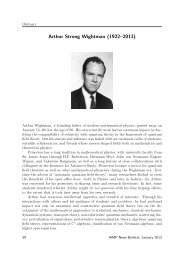Representations of positive projections 1 Introduction - Mathematics ...
Representations of positive projections 1 Introduction - Mathematics ...
Representations of positive projections 1 Introduction - Mathematics ...
Create successful ePaper yourself
Turn your PDF publications into a flip-book with our unique Google optimized e-Paper software.
'Pi (f) 1Ai for all f 2 Ai (Ei) (see (29)). Since 2 ( (e)) = 1 (e) for all<br />
e 2E 1 it follows that 'P2 ( (f)) = 'P1 (f) for all f 2 A 1 (E 1). We de ne<br />
by<br />
0<br />
0 : K (CB1 E 1) ! K (CB2 E 2)<br />
nX<br />
i=1<br />
qifi<br />
!<br />
=<br />
nX<br />
i=1<br />
(qi) (fi) (31)<br />
for all fqig n<br />
i=1 in CB1 and all ffig n<br />
i=1 in A 1 (E 1). First we observe that 0 is<br />
well de ned. Indeed, if f = P n<br />
i=1 qifi has standard form f = P m<br />
j=1 pjgj, then<br />
it is easy to see that<br />
nX<br />
i=1<br />
(qi) (fi) =<br />
mX<br />
j=1<br />
(pj) (gj).<br />
Since the standard form <strong>of</strong> an element inK (CB1 E1) is unique, it follows that<br />
0 is well de ned by (31). Since and are f-algebra homomorphisms it<br />
is now also clear that 0 is an f-algebra homomorphism.<br />
Take f 2 K (CB1 E1) and write f = Pn i=1 qifi with fqig n<br />
i=1 in CB1<br />
ffig<br />
and<br />
n<br />
i=1 in A1 (E1). Then<br />
P 1f =<br />
nX<br />
i=1<br />
P 1 (qifi) =<br />
nX<br />
i=1<br />
qiP 1 (fi) =<br />
nX<br />
i=1<br />
'P1 (fi) qi<br />
and so P 1 [K (CB1 E 1)] K (CB1 E 1). Moreover, using that 'P2 ( (fi)) =<br />
'P1 (fi), we nd that<br />
0 (P 1f) =<br />
=<br />
nX<br />
i=1<br />
nX<br />
i=1<br />
'P1 (fi) (qi) =<br />
(qi) P 2 ( (fi)) =<br />
= P 2<br />
nX<br />
i=1<br />
nX<br />
i=1<br />
nX<br />
i=1<br />
(qi) (fi)<br />
'P2 ( (fi)) (qi)<br />
P 2 ( (qi) (fi))<br />
!<br />
= P 2 ( 0f) :<br />
This shows that 0 P 1 = P 2 0.<br />
Let K 1 be the 1A1-uniform closure <strong>of</strong> K (CB1 E 1)inA 1. Then 0 extends<br />
uniquely to an f-algebra homomorphism 1 : K 1 ! A 2. Since CB1 K 1 and<br />
1 (q) = 0 (q) = (q) for all q 2CB1, it follows from Freudenthal's spectral<br />
46


